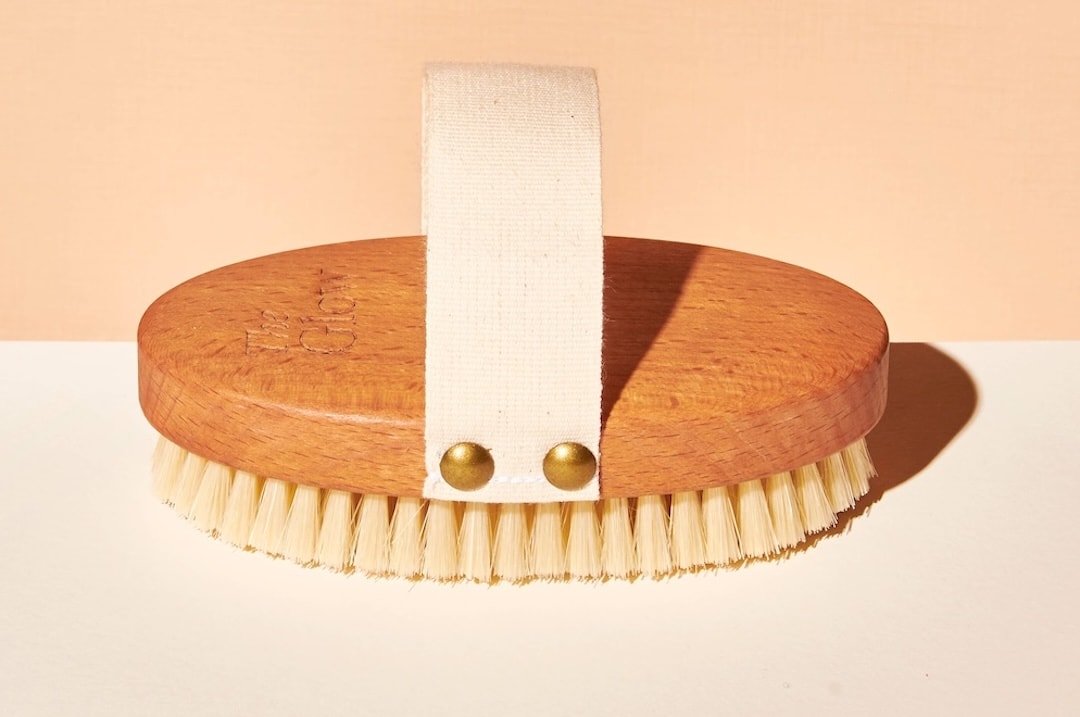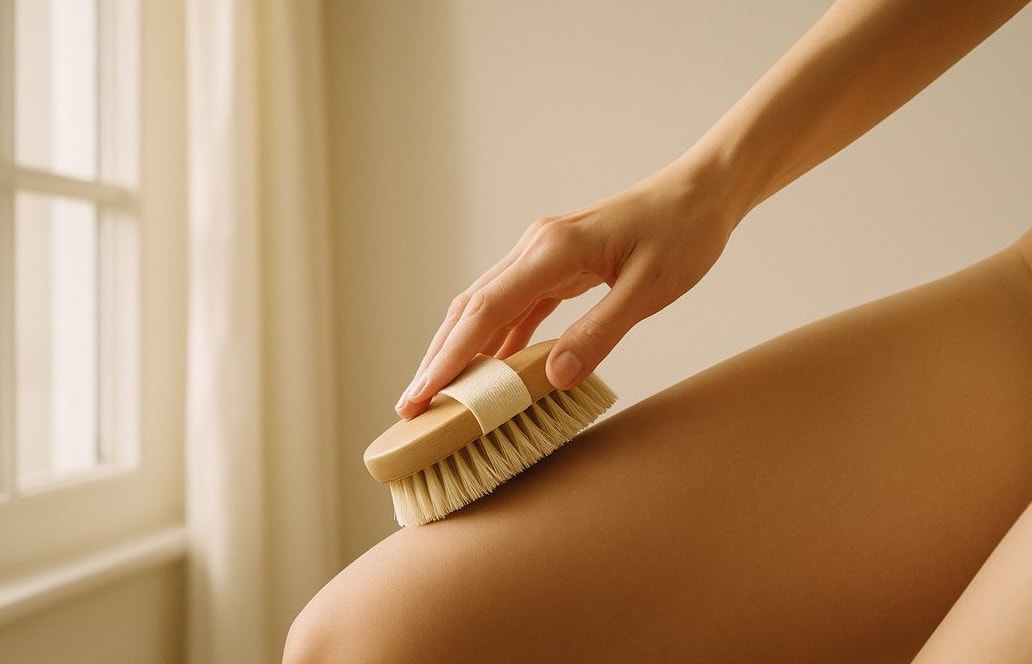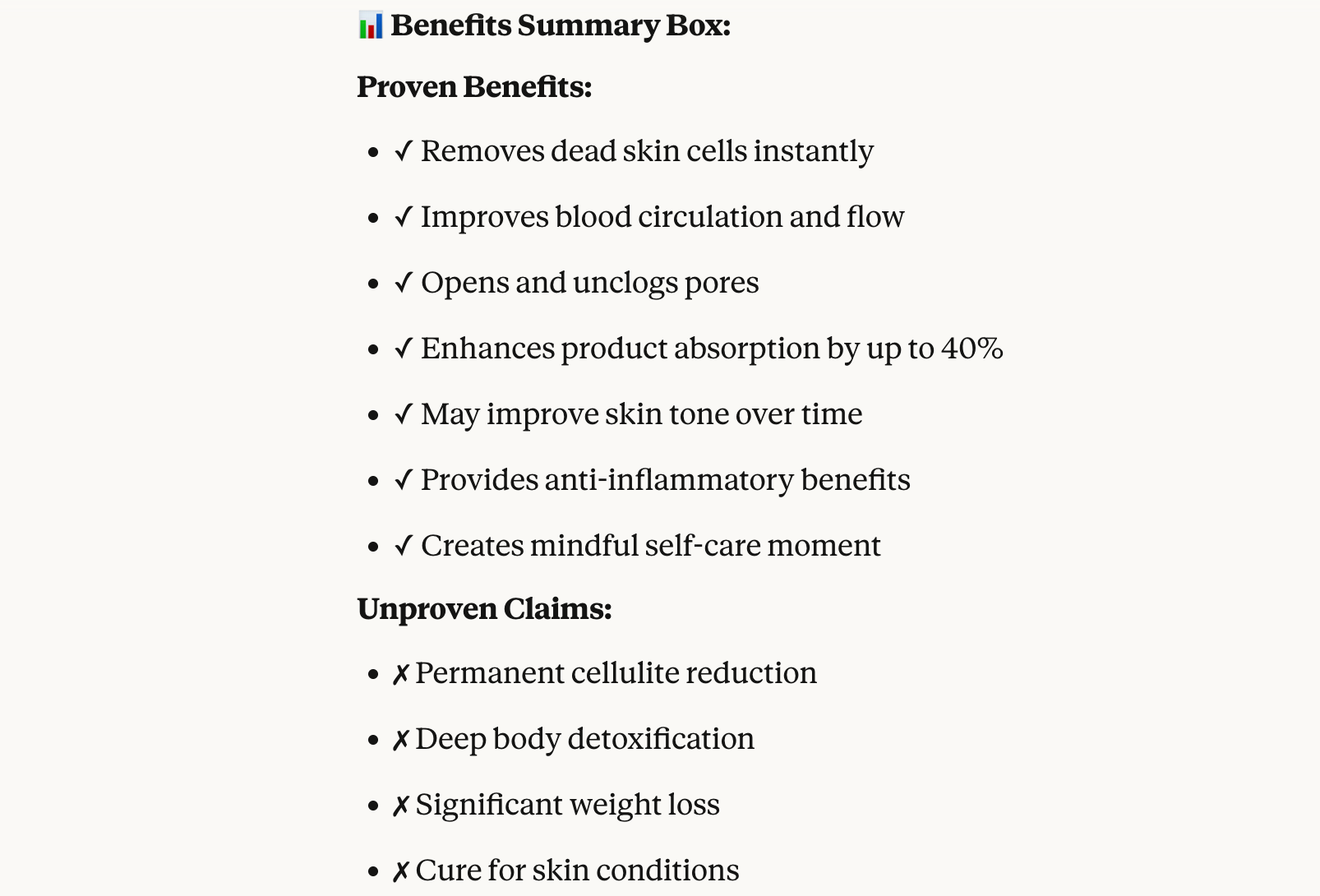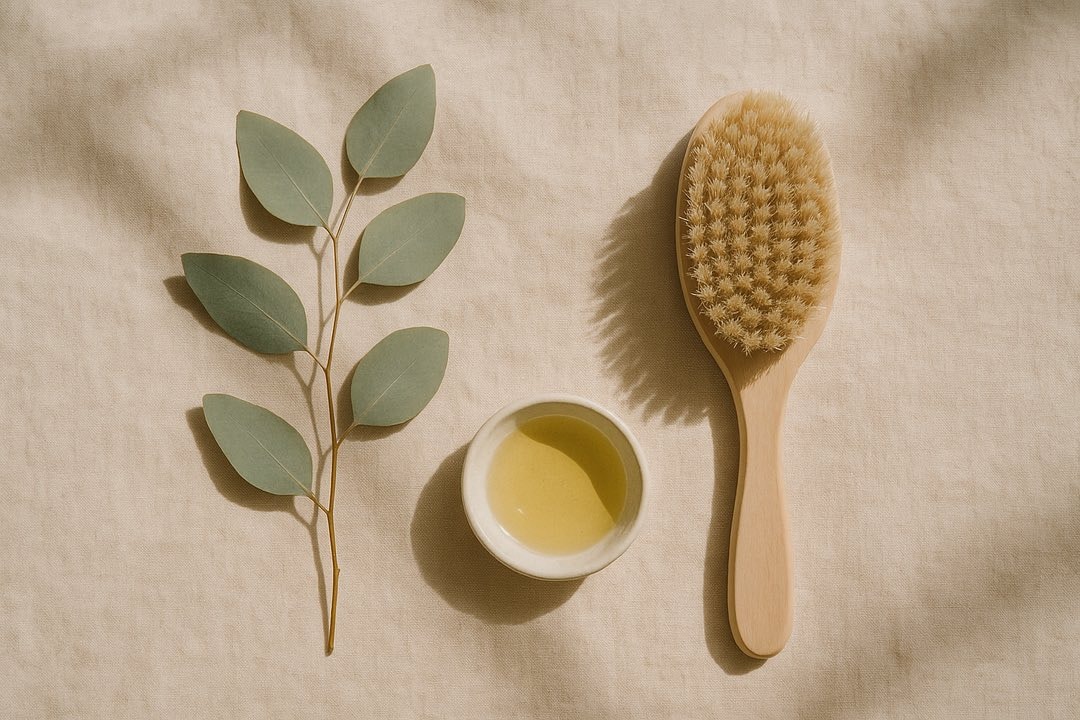Table of Contents
Dry Brushing: Benefits, Technique, and Tips for Glowing Skin
This page may contain affiliate links. We may earn a commission on purchases, at no additional cost to you. Learn more →
Have you ever looked at your skin and felt disappointed by how dull and rough it looks? Maybe you've tried every lotion on the shelf, but your skin still feels dry and lackluster. You're standing in the shower, running your hand over your legs or arms, and all you feel is that rough, almost sandpaper-like texture. It's frustrating, isn't it?
Here's what's happening: dead skin cells are building up on your body, creating that dull, lifeless appearance. Your skin is desperately trying to renew itself, but it needs help. And here's the beautiful part—that help doesn't come from expensive treatments or complicated routines.
There's a simple, ancient practice that takes just five minutes: dry brushing. It's exactly what it sounds like—brushing your skin with a natural bristled brush before you shower. No lotions, no scrubs, no chemicals. Just you, a brush, and a few mindful strokes that can reveal the smooth, glowing skin that's been hiding underneath all along. Ready to discover how?
This guide covers everything you need to know about dry brushing: what it is, the science-backed benefits of dry brushing, step-by-step technique for beginners, safety precautions, and expert tips for incorporating this anti-inflammatory skincare routine into your daily life. Learn the best technique for brushing your skin, how often to dry brush, and how to choose the right body brush for your skin type!

Key Takeaways
-
What is dry brushing? An ancient Ayurvedic practice using a natural bristled brush on dry skin to exfoliate dead skin cells, stimulate blood circulation, and support lymphatic drainage.
-
Proven benefits: Removes dead skin and flaky skin cells for smoother, radiant skin; improves blood flow and circulation; may improve skin tone and elasticity over time; enhances absorption of body care products; provides anti-inflammatory benefits.
-
Best technique: Always brush toward your heart using long, upward strokes on limbs and clockwise circular motions on abdomen. Start at feet, work up to torso, then brush arms—takes just 2-5 minutes.
-
Timing matters: Best done in the morning before showering (it's energizing—not before bed!). Start with 1-2 times weekly; can increase to daily if your skin tolerates it well.
-
Essential aftercare: Always shower after brushing your skin to rinse dead skin, then immediately moisturize with natural body oil or lotion to prevent dry skin and lock in hydration.
-
Safety first: Avoid brushing over sensitive skin, eczema, psoriasis, cuts, or inflamed areas. Use light pressure—dry brushing should never hurt. Choose a natural bristled body brush appropriate for your skin type.
-
Manage expectations: While dry brushing offers real health benefits for skin texture and blood circulation, it won't permanently eliminate cellulite or "detox" your body. Focus on the proven benefits: smoother, glowing skin and a mindful self-care ritual
What Is Dry Brushing?
Dry brushing is exactly what it sounds like—brushing your skin with a dry, natural bristled brush before you shower. This practice comes from Ayurveda and Traditional Chinese Medicine, where it's been used for centuries to exfoliate the skin and stimulate circulation as part of cleansing rituals.
When you practice dry brushing, you're using a stiff bristled brush or dry body brush on completely dry skin—no water, no soap, no oils. Just you, your body brush, and a few mindful minutes. According to dermatologist Dr. Nicole Hayre, the primary purpose is to "exfoliate your skin" by manually sweeping away dull, dead skin from the surface.
The practice has exploded in popularity recently. By early 2023, the hashtag #drybrushing amassed over 127 million views on TikTok, with wellness enthusiasts and celebrities like Gwyneth Paltrow touting the benefits of dry brushing. But let's separate the hype from reality so you can make this practice part of your skincare routine with confidence.
Benefits of Dry Brushing: What Actually Works for Your Skin
Removing Dead Skin and Flaky Skin Cells for Smoother Skin
Think about this: every day, your skin sheds millions of dead skin cells. Where do they go? They sit on your skin's surface, making it look dull and feel rough. Does this sound familiar?
This is where dry brushing truly shines. The mechanical exfoliation from those natural bristles buffs away dead skin cells and flaky skin cells that make your skin look ashy or feel rough. You'll notice the difference right away—your skin feeling soft and looking more radiant.
As explained in Cleveland Clinic's dermatologist-reviewed article, the bristles help open pores and unclog them on your body, allowing any moisturizer you apply afterward to penetrate better and work more effectively. Think of it as preparing a canvas—you're removing the dull layer so everything else in your skincare routine works more effectively.
This benefit works for most skin types, though those with sensitive skin should proceed more gently. The immediate smoothness you feel after brushing your skin is one of the most satisfying aspects of this practice.
💡 Quick Tip Box: The "Touch Test": Run your hand over your shin or forearm before dry brushing. Feel that roughness? Now do it again after brushing and showering. The difference is immediate and unmistakable—that's the power of removing dead skin cells.

Improved Blood Flow and Blood Circulation for Glowing Skin
When you brush your skin in those long, sweeping strokes with your dry body brush, you're doing more than just removing dead skin. The firm strokes stimulate blood flow to the massaged areas, often resulting in a temporary rosy glow or plumping of the skin. That improved blood circulation means oxygen-rich and nutrient-rich blood is reaching your skin more efficiently, giving you that coveted glowing skin appearance.
Dr. Shilpi Khetarpal, a board-certified dermatologist at Cleveland Clinic, confirms in Cleveland Clinic's expert analysis that "dry brushing increases blood circulation and promotes lymph flow," which helps the body eliminate toxins through sweating. By unclogging pores through exfoliation, your body can sweat more effectively and flush out waste naturally. This boost in blood flow is what creates that radiant skin effect many people notice immediately after a dry brushing session.
Anti-Inflammatory Benefits and Long-Term Skin Improvements
Here's something exciting: when done correctly, dry brushing can actually serve as an anti-inflammatory skin treatment. The gentle stimulation and improved circulation can help reduce inflammation in the skin, supporting your body's natural healing processes.
Beyond the immediate effects, regular dry brushing may offer long-term benefits for your skin. With consistent practice over time, you may notice improvements in skin tone and elasticity. The combination of regular exfoliation, improved blood circulation, and the plumping effect on the skin's surface can contribute to firmer, more youthful-looking skin over weeks and months of regular use.
This doesn't mean dry brushing reverses aging—but as part of a holistic skincare routine that includes proper hydration, nutrition, and sun protection, it can support your skin's overall health and appearance.
Enhanced Product Absorption: Your Skincare Works Better
One of the most practical benefits of dry brushing is how it transforms the effectiveness of your body care products. After removing that layer of dead skin and flaky skin cells, your body lotions, oils, and treatments can apply more smoothly, absorb faster, and work better than they would on un-exfoliated skin.
This means you're getting more value from every product you use. The nutrients, moisturizers, and active ingredients can penetrate more deeply into freshly brushed skin rather than sitting on top of dead skin cells. For anyone investing in high-quality, natural body care products, dry brushing ensures you're getting the maximum benefit from them.
Supporting Your Lymphatic System and Lymphatic Drainage
The lymphatic system is part of your immune system, carrying lymph fluid that transports immune cells and filters waste throughout your body. In theory, brushing toward the heart with your body brush might help support lymphatic drainage by encouraging the movement of lymph fluid.
However, medical experts urge caution here: there's minimal scientific evidence that dry brushing meaningfully improves lymphatic drainage. According to Verywell Health's evidence-based analysis, manual lymphatic drainage massage (a specific therapeutic technique used for lymphedema patients) can reduce swelling, but a simple brush stroke is unlikely to replicate that effect. The body's lymph circulation mostly depends on internal factors like muscle movement and breathing.
That said, by improving circulation and helping you sweat more efficiently, dry brushing does support your lymphatic system's natural processes in an indirect way.
Health Benefits Beyond the Skin's Surface
One benefit of dry brushing that doesn't show up in lab tests is the mind-body experience. Many people find the gentle, rhythmic strokes both relaxing and energizing. As Cleveland Clinic dermatologists note, it can stimulate the nervous system, giving an invigorated feeling similar to a light massage. It's a few minutes to connect with your body, breathe deeply, and show yourself care.
For beginners to wellness routines, dry brushing is appealing because it's simple and takes just 2–5 minutes. It can be a mindful way to start your day, focusing on your body and breath as you brush. This mental health benefit is real and valuable, even if it's harder to measure than smoother skin.

The Truth About Cellulite Reduction and Detox Claims
Let's be honest here, while dry brushing has real benefits, it's not a miracle cure.
-
Cellulite Reduction: Mayo Clinic experts explicitly state: "Dry brushing, massage and skin wraps don't work as cellulite treatments". Cleveland Clinic concurs, noting there is "no proof" that dry brushing reduces cellulite or its appearance in any lasting way. You might see temporary smoothing right after brushing because the increased blood flow plumps the skin, but this effect is fleeting.
As Dr. Shilpi Khetarpal explains in her Cleveland Clinic interview, "It's likely what people interpret as cellulite reduction is really just a temporary plumping of the skin from increased blood circulation." The appearance of cellulite might improve momentarily, but you're not actually breaking down the fat deposits or connective tissue that cause cellulite. For true cellulite reduction, lifestyle changes are your best options.
-
Detoxification: There's minimal scientific evidence that dry brushing meaningfully detoxifies your body. As Verywell Health bluntly explains, you "can't brush toxins out of the body". Your liver and kidneys handle detoxification—not your skin brush. Cleveland Clinic's analysis confirms that by improving blood circulation and helping you sweat more efficiently, dry brushing does support your body's natural elimination processes in a small, indirect way—but it's not a proven detox method on its own.
How Do You Do Dry Brushing?
Ready to try it? Here's the best technique for dry brushing safely and effectively, adapted for different skin types.
Choose the Right Dry Body Brush
Select a natural bristled brush made from plant fibers (like sisal or jute) or boar hair. You definetely should avoid synthetic bristles—they can be too harsh on all skin types and you dont want microplastics enter your skin. Look for a body brush with a long handle so you can reach your back easily. The bristles should be firm enough to exfoliate but not so stiff that they scratch.
If you have sensitive skin, consider starting with a softer brush or even testing on a small area first. For normal to dry skin types, a medium-firm brush works well.
Important: Make sure both your skin and the brush are completely dry before you start.
Best Time to Dry Brush: Morning Only
Dry brushing is very invigorating and stimulating, which means it's best done in the morning before your shower. The increased blood circulation and nervous system stimulation can energize you and help you feel awake—perfect for starting your day.
Avoid dry brushing before bed. The stimulating effects can interfere with your ability to wind down and fall asleep. Save this practice for your morning routine when you want that energized feeling.
Step 1: Start at Your Feet and Brush Upward
Begin at your feet or ankles with light pressure. Using long, sweeping strokes, brush upward toward your heart—this follows the natural flow of lymph and blood circulation toward your heart. This directional brushing your skin technique is key for supporting lymphatic drainage.
For your legs, work methodically from the front to the back of your right foot, up through the calf and thigh to the buttocks. Then repeat on your left leg. Cover each section with 2-4 strokes. The legs often accumulate the most dead skin and flaky skin cells, so you'll really notice the difference here.
Pay special attention to rough spots like your knees, where dead skin tends to accumulate. These areas may need a few extra gentle strokes to smooth them out.
Step 2: Move to Your Torso and Back
For your abdomen, use gentle clockwise circular motions. Here's the precise technique: start at the lower right side of your abdomen, then brush clockwise upward toward your ribs. This direction follows your digestive tract and feels more natural. Be especially gentle on your stomach—this area is sensitive across all skin types.
For your abdomen and lower back, experts recommend using gentle clockwise circular motions on your belly, then brush upward on your lower back toward your heart. Be especially gentle on your stomach—this area is sensitive across all skin types.
For your chest (avoiding nipples), use very light pressure or skip it entirely if you have sensitive skin. When brushing your back with your long-handle dry body brush, start from the lower back and brush upward toward the upper back, always directing strokes toward your heart to support the lymphatic system.
Step 3: Brush Your Arms and Hands
Start at your hands, brushing the palms and backs, then sweep upward from wrist to elbow, elbow to shoulder. Always brush toward your armpit, which is a major lymph node cluster in your lymphatic system. Cover inner and outer surfaces of the arms.
Don't forget to pay special attention to rough spots like your elbows, which tend to accumulate dry, flaky skin.
Finish with a few strokes across your shoulders and collarbone, moving toward your heart.
The Best Technique: Duration and Pressure
The entire process should take 2-5 minutes. Holistic esthetician Dr. Tammy Fender suggests about 2 minutes of brisk brushing is sufficient. Use light pressure on sensitive or thin-skinned areas and medium pressure on thicker-skinned areas like your feet or elbows.
Here's the key: dry brushing should not hurt. If your skin is turning bright red or stinging, you're pressing too hard. A mild pink glow is normal (that's increased blood circulation), but redness, burning, or scratches mean you need to ease up. This applies to all skin types, though those with sensitive skin should be especially cautious.

Step 4: Shower and Moisturize for Radiant Skin
Iimmediately after brushing your skin, take a warm shower to rinse off the dead skin cells and flaky skin cells you've dislodged. Use gentle soap and avoid harsh scrubs—you've already exfoliated.
After showering, this step is crucial for your skincare routine: apply a natural body oil or moisturizer. Dry brushing can leave your dry skin even drier, so replenish moisture with plant-based oils like almond, coconut, or jojoba. Your freshly exfoliated skin will absorb it beautifully, leaving you with that soft, glowing skin you're after. This step is what transforms your skin from simply exfoliated to truly radiant skin.
Caring for Your Body Brush
Take a moment to clean your dry body brush regularly. Every week or two, gently wash the bristles with mild soap and warm water, then let it air dry completely—bristles down—before the next use. Don't share your body brush with others for hygiene reasons. A well-maintained brush will serve your skincare routine for months.
Safety First: Adapting Dry Brushing for Different Skin Types
While dry brushing works for most skin types, here's when to skip it or proceed with extra caution:
Avoid brushing over:
-
Cuts, scrapes, burns, or any broken skin
-
Active eczema or psoriasis patches
-
Rashes, acne breakouts, or sunburn
-
Any areas of irritated or inflamed skin, as brushing can worsen inflammation or spread bacteria
For sensitive skin types: Start with a very soft-bristled brush or even a dry washcloth. As Dr. Khetarpal advises, if brushing even with light pressure causes redness or swelling, stop right away. Sensitive skin may need gentler, less frequent sessions.
For dry skin: While dry brushing can help remove flaky skin cells, it's essential that you moisturize thoroughly afterward. Dry skin types need this step more than any other to prevent excess dryness and maintain that healthy, radiant skin glow.
Skip facial skin: Most experts do not recommend dry brushing the face with a body brush. Facial skin requires different, gentler exfoliation methods specifically designed for that skin type.
Frequency matters for all skin types: Start with 1-2 times per week and see how your skin reacts. You can gradually increase frequency to daily if your skin tolerates it well and demands more. For many people, 2-3 times weekly is enough to get the benefits of dry brushing without irritation. The key is to take it slow until your skin gets used to it—don't overdo it or brush too aggressively, as too much pressure will only irritate the skin and cause inflammation that can damage the skin barrier.

Make Dry Brushing Part of Your Journey to Radiant Skin
Dry brushing isn't about perfection. It's about taking a few moments to care for your body in a gentle, natural way that fits seamlessly into your skincare routine. You don't need fancy equipment or complicated techniques—just a good dry body brush, a little time, and the intention to support your skin's natural renewal process.
Will it transform your life overnight? No. Will it give you softer skin by removing dead skin and flaky skin cells, improved blood circulation, a moment of mindfulness, and that lovely post-massage glow? Absolutely. The benefits of dry brushing are real—smoother skin, radiant skin, improved blood flow, and support for your lymphatic system, even if it's not the miracle cure some claim.
Different skin types will respond differently. If you have dry skin, extra moisturizing is essential. If you have sensitive skin, start gently. But for most people, brushing your skin with a natural body brush 2-3 times per week can become a cherished part of their skincare routine.
Start small—once a week, a few gentle strokes with your dry body brush, and see how it feels. Your skin will tell you what it needs. And remember: the goal isn't to scrub harder or brush longer. The goal is to invigorate, not irritate. To support, not force. To care for your body the way it deserves to be cared for—gently, naturally, and with respect.
The best technique is the one that works for your unique skin type, fits into your life, and makes you feel good. That's the real health benefit—a practice that connects you to your body and supports your natural radiance.

FAQ to Dry Brushing: Health Benefits and Best Practices
How often should you dry brush your body?
Start with once or twice weekly to see how your skin type responds. If your skin tolerates it well, you can increase to 2-3 times per week. Listen to your skin—if it becomes very dry, flaky, or irritated, reduce frequency.
Should you dry body brush before or after shower?
Always before, on completely dry skin. Dry brushing on dry skin is most effective for removing dead skin and is gentler than scrubbing wet skin. Then you can rinse off all those dead skin cells and flaky skin cells in the shower, completing your skincare routine with moisturizer.
What are the real benefits of dry brushing?
The proven benefits of dry brushing include: mechanical exfoliation that removes dead skin and flaky skin cells, improved blood circulation and blood flow to the skin's surface, temporarily increased radiant skin appearance, and the mental health benefits of a mindful self-care ritual. The lymphatic drainage and detox claims have minimal scientific support, though dry brushing may indirectly support your lymphatic system.
Can dry brushing help with eczema?
No—avoid brushing your skin over active eczema or psoriasis. Brushing inflamed areas can aggravate them and risk infection. If you have dry skin types, you can dry brush unaffected areas gently, but you absolutely must moisturize thoroughly afterward. For those with dry skin, the exfoliation can help remove flaky skin cells, but hydration is critical.
What are the downsides of dry brushing?
The main risks are irritation from brushing too hard or too often, increased dry skin if you don't moisturize afterward, and potential inflammation if done over sensitive or broken skin. Some skin types may find it too harsh regardless of pressure. The key is gentleness and moderation.













